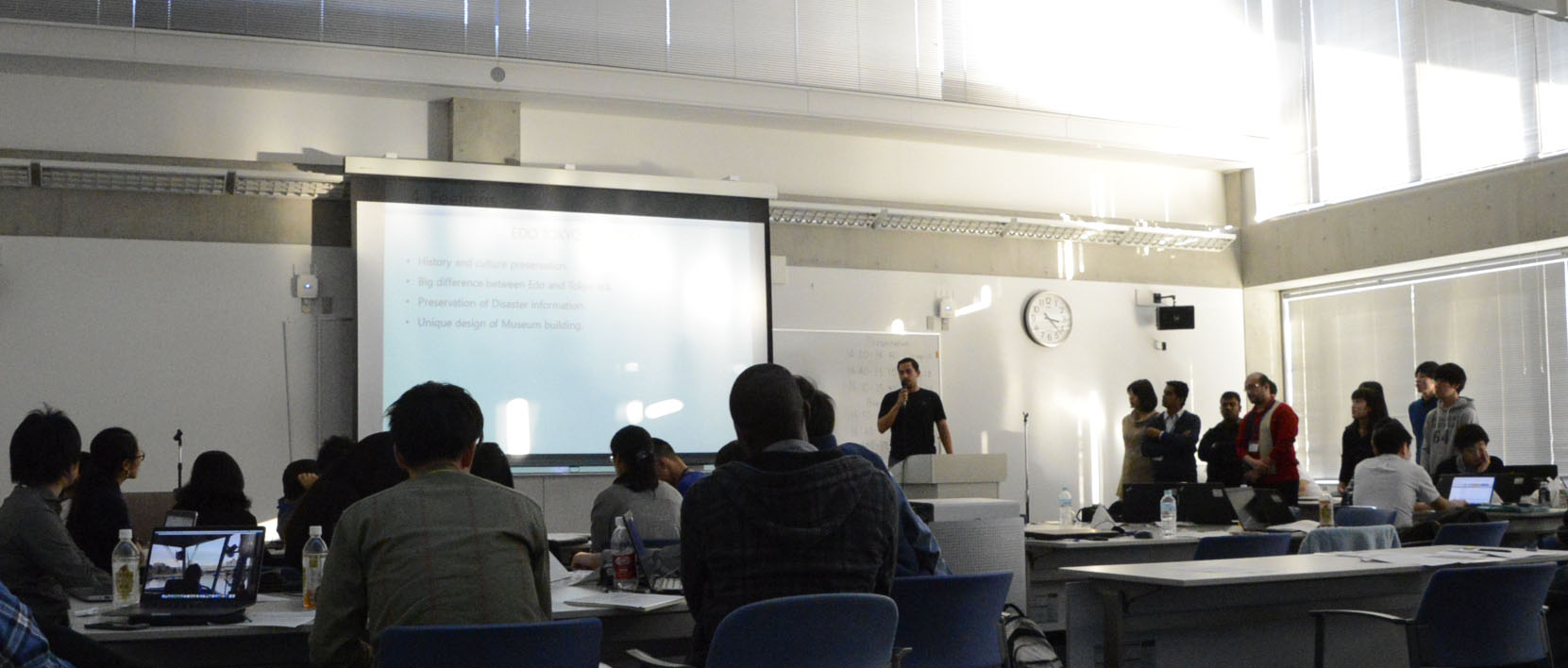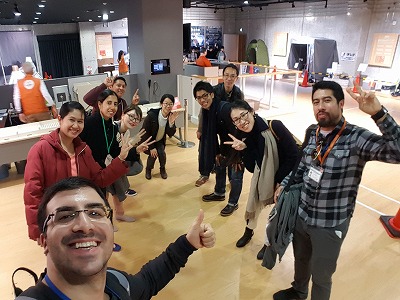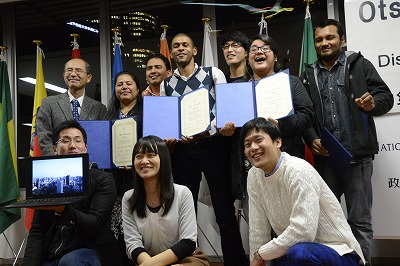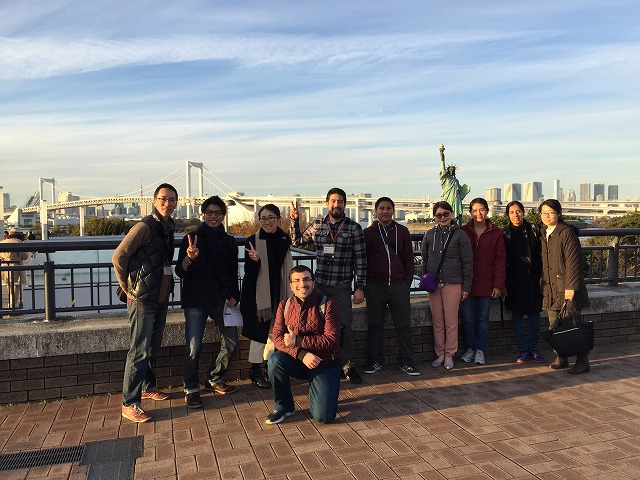News Archives
2016.12.9
DMP international students and Japanese students conducted joint fieldwork on disaster preparation.
GRIPS Disaster Management Policy Program (DMP) is a one-year master’s program to develop experts in the field of disaster preparation in developing countries. It includes Seismology Course, Earthquake Engineering Course, Tsunami Disaster Mitigation Course, and Water-related Disaster Management Course and currently hosts 30 international students who entered in October 2016.
As part of the DMP curriculum, joint fieldwork with the Public Policy Program (Infrastructure Policy Concentration and Disaster Risk Management Concentration) was held on December 8 and 9 (Thursday and Friday) to observe disaster-related facilities and systems in Tokyo.
The participants were 30 international students from DMP and 26 Japanese students from the Public Policy Program. The students were divided into 6 groups, and selected tour destinations matched to each group’s interests. Led by the Japanese participants, they spent half a day visiting areas within the metropolis. On the following day, they prepared presentation materials, then gave presentations and conducted commendations based on student votes.
The varied content of the visits included observation of The Tokyo Rinkai Disaster Prevention Park to learn about wide-area evacuation and emergency recovery activities; a visit to the Japan Weather Association to see forecasting of weather, with its deep ties to natural disasters, in action; and a hands-on experience at the Kojimachi Fire Department facilities. Other groups visited Tokyo Skytree and Tokyo Tower, to gain a bird’s eye view of regional characteristics and city planning to study the relationship with disaster preparation and flood control measures, or to focus on the earthquake resistance of the structure. Groups also visited Edo-Tokyo Museum and Asakusa, providing an opportunity for the international students, who came to Japan about three months earlier, to deepen their understanding of Japanese history and culture.
For the Japanese students, the fieldwork provided opportunities to not only practice communicating in English about their own fields of specialty and Japanese culture, but also to encounter diverse values through two days of interactions. Kazuki Umezaki of the Disaster Risk Management Concentration, who served as a group leader, said, “I was able to spend these two days very meaningfully. It was my first time to engage with international students so deeply. While there were many difficulties, I was also helped much by the international students, and I think we were able to learn from each other. I believe that this fieldwork will become an asset in life.”
- Impressions of participating students, 1:
Hisano Abe
Public Policy Program, Infrastructure Policy Concentration
Our group planned its fieldwork route, with changes among a number of modes of transportation, under the theme of sharing information on disaster preparation issues and countermeasures in Japan. Through the day’s fieldwork, we shared ideas and information related to Japan’s disaster preparation, including virtually experiencing an earthquake directly under Tokyo, from occurrence to evacuation, at the Sona Area Tokyo disaster preparation learning facility in the Tokyo Rinkai Disaster Prevention Park; disaster preparation in the Odaiba area, which is built on landfill; the response by railways and new modes of transportation (Yurikamome) in the event of an earthquake; transport by SKYBUS, to experience the varied townscapes of the city center, issues such as traffic jams, and the role of emergency transport roads; the vibration damping structure of Skytree and its role as a disaster preparation base; and the idea behind the fire prevention area around Senso-ji Temple in Asakusa.
A few days before the fieldwork, I had conducted a tour of Tokyo Station for DMP students as an employee of a railway company. With pride as a “traffic professional,” I shared information on issues and countermeasures concerning disasters befalling transportation infrastructure. In particular, the students were very interested in what we had learned through experiences of the Great East Japan Earthquake, and that railways in Japan emphasize safety over fixed schedules. Moreover, I heard comments that the townscapes of Tokyo, Japan’s capital, are not only groups of buildings but are also wonderful with a variety of expressions, including lovely nature and landscapes. I was reminded that the characteristics of neighborhoods in every area, where we spend time casually, have been brought about through urban planning.
I am glad that through this fieldwork, I was able to share an aspect of disaster preparation in Japan, and that I was able to rediscover things while friendships grew within the group.
Hisano Abe:
As a civil engineer in the construction department of the railway company that dispatched her to the program, Hisano Abe works in a variety of construction projects in design, ordering, construction supervision, and other capacities, to strengthen the management foundations of railway networks and lifestyle service-related facilities and to make contributions to town planning in areas along rail lines. She is currently engaged in tourism statistics-based research on the state of passenger flow in the Infrastructure Policy Concentration of the Public Policy Program.
- Impressions of participating students, 2:
Lucas Mikosz
Disaster Management Policy Program, Water-related Disaster Management Course
In the Integrated Student Seminar I was in group 3B. Japanese members guided us to famous Tokyo landmarks related to disaster management. The first stop was a park located on the banks of the Sumida River. Then we went to the Tokyo Skytree and finally we went on an amphibious bus trip on the old Naka River.
During the trip we had the opportunity to exchange experiences with students from different countries and with different backgrounds. Some interesting discussions developed about how disaster management is conducted in each participant’s country and how Japanese know-how can be applied in other settings.
Together we organized a presentation for the other students, to show them the places we had visited and give our perceptions of those landmarks. The presentations showed a lot of teamwork and creativity. There were many laughs as each team exploited all the resources available to make their information not only technically accurate but also interesting and memorable!
In the end, it was awesome to exchange experiences with Japanese students, and as a bonus we also got to do some sightseeing in Tokyo and make new friends!
Lucas Mikosz:
Lucas Mikosz is from Curitiba, a region in the south of Brazil. A geologist, he works for the National Center of Risk and Disaster Management, which is part of the National Department of Civil Protection and Defense, located in Brasilia. His major roles in his institution are to analyze infrastructure reconstruction processes areas affected by disasters, and to supervise hazard mapping contracts. He worked on Brazil’s GIDES Project, a partnership project involving the Brazilian and Japanese governments, for mitigation of sediment related disasters. Lukas has also been involved in a variety of environmental studies and hazard mapping projects. He enrolled in the Disaster Management Policy Program at GRIPS in October 2016.
Public Relations, GRIPS
News Archives
2016.12.9
DMP international students and Japanese students conducted joint fieldwork on disaster preparation.
GRIPS Disaster Management Policy Program (DMP) is a one-year master’s program to develop experts in the field of disaster preparation in developing countries. It includes Seismology Course, Earthquake Engineering Course, Tsunami Disaster Mitigation Course, and Water-related Disaster Management Course and currently hosts 30 international students who entered in October 2016.
As part of the DMP curriculum, joint fieldwork with the Public Policy Program (Infrastructure Policy Concentration and Disaster Risk Management Concentration) was held on December 8 and 9 (Thursday and Friday) to observe disaster-related facilities and systems in Tokyo.
The participants were 30 international students from DMP and 26 Japanese students from the Public Policy Program. The students were divided into 6 groups, and selected tour destinations matched to each group’s interests. Led by the Japanese participants, they spent half a day visiting areas within the metropolis. On the following day, they prepared presentation materials, then gave presentations and conducted commendations based on student votes.
The varied content of the visits included observation of The Tokyo Rinkai Disaster Prevention Park to learn about wide-area evacuation and emergency recovery activities; a visit to the Japan Weather Association to see forecasting of weather, with its deep ties to natural disasters, in action; and a hands-on experience at the Kojimachi Fire Department facilities. Other groups visited Tokyo Skytree and Tokyo Tower, to gain a bird’s eye view of regional characteristics and city planning to study the relationship with disaster preparation and flood control measures, or to focus on the earthquake resistance of the structure. Groups also visited Edo-Tokyo Museum and Asakusa, providing an opportunity for the international students, who came to Japan about three months earlier, to deepen their understanding of Japanese history and culture.
For the Japanese students, the fieldwork provided opportunities to not only practice communicating in English about their own fields of specialty and Japanese culture, but also to encounter diverse values through two days of interactions. Kazuki Umezaki of the Disaster Risk Management Concentration, who served as a group leader, said, “I was able to spend these two days very meaningfully. It was my first time to engage with international students so deeply. While there were many difficulties, I was also helped much by the international students, and I think we were able to learn from each other. I believe that this fieldwork will become an asset in life.”
- Impressions of participating students, 1:
Hisano Abe
Public Policy Program, Infrastructure Policy Concentration
Our group planned its fieldwork route, with changes among a number of modes of transportation, under the theme of sharing information on disaster preparation issues and countermeasures in Japan. Through the day’s fieldwork, we shared ideas and information related to Japan’s disaster preparation, including virtually experiencing an earthquake directly under Tokyo, from occurrence to evacuation, at the Sona Area Tokyo disaster preparation learning facility in the Tokyo Rinkai Disaster Prevention Park; disaster preparation in the Odaiba area, which is built on landfill; the response by railways and new modes of transportation (Yurikamome) in the event of an earthquake; transport by SKYBUS, to experience the varied townscapes of the city center, issues such as traffic jams, and the role of emergency transport roads; the vibration damping structure of Skytree and its role as a disaster preparation base; and the idea behind the fire prevention area around Senso-ji Temple in Asakusa.
A few days before the fieldwork, I had conducted a tour of Tokyo Station for DMP students as an employee of a railway company. With pride as a “traffic professional,” I shared information on issues and countermeasures concerning disasters befalling transportation infrastructure. In particular, the students were very interested in what we had learned through experiences of the Great East Japan Earthquake, and that railways in Japan emphasize safety over fixed schedules. Moreover, I heard comments that the townscapes of Tokyo, Japan’s capital, are not only groups of buildings but are also wonderful with a variety of expressions, including lovely nature and landscapes. I was reminded that the characteristics of neighborhoods in every area, where we spend time casually, have been brought about through urban planning.
I am glad that through this fieldwork, I was able to share an aspect of disaster preparation in Japan, and that I was able to rediscover things while friendships grew within the group.
Hisano Abe:
As a civil engineer in the construction department of the railway company that dispatched her to the program, Hisano Abe works in a variety of construction projects in design, ordering, construction supervision, and other capacities, to strengthen the management foundations of railway networks and lifestyle service-related facilities and to make contributions to town planning in areas along rail lines. She is currently engaged in tourism statistics-based research on the state of passenger flow in the Infrastructure Policy Concentration of the Public Policy Program.
- Impressions of participating students, 2:
Lucas Mikosz
Disaster Management Policy Program, Water-related Disaster Management Course
In the Integrated Student Seminar I was in group 3B. Japanese members guided us to famous Tokyo landmarks related to disaster management. The first stop was a park located on the banks of the Sumida River. Then we went to the Tokyo Skytree and finally we went on an amphibious bus trip on the old Naka River.
During the trip we had the opportunity to exchange experiences with students from different countries and with different backgrounds. Some interesting discussions developed about how disaster management is conducted in each participant’s country and how Japanese know-how can be applied in other settings.
Together we organized a presentation for the other students, to show them the places we had visited and give our perceptions of those landmarks. The presentations showed a lot of teamwork and creativity. There were many laughs as each team exploited all the resources available to make their information not only technically accurate but also interesting and memorable!
In the end, it was awesome to exchange experiences with Japanese students, and as a bonus we also got to do some sightseeing in Tokyo and make new friends!
Lucas Mikosz:
Lucas Mikosz is from Curitiba, a region in the south of Brazil. A geologist, he works for the National Center of Risk and Disaster Management, which is part of the National Department of Civil Protection and Defense, located in Brasilia. His major roles in his institution are to analyze infrastructure reconstruction processes areas affected by disasters, and to supervise hazard mapping contracts. He worked on Brazil’s GIDES Project, a partnership project involving the Brazilian and Japanese governments, for mitigation of sediment related disasters. Lukas has also been involved in a variety of environmental studies and hazard mapping projects. He enrolled in the Disaster Management Policy Program at GRIPS in October 2016.
Public Relations, GRIPS









